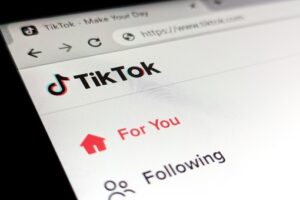As TikTok rapidly emerged to surpass 1 billion monthly active young users, joyful dances and comedy memes understandably captured global attention far more than the underbelly. Yet behind the lighthearted veneer, researchers confirm toxic dangers haunt the dynamically addictive platform, warranting parental awareness and oversight investments. Ratcheting harm prevention remains imperative before vulnerabilities come of age.
Defining Digital Toxicity
While phrases like “social media toxicity” permeate parenting forums and headlines, operational definitions help contextualize tangible risks facing youth overly immersed in unmoderated digital environments filling developmental free time.
Normalizing Harmful Challenges
Videos dare young viewers toward dangerous stunts like the prohibited “Blackout Challenge” linked to multiple child deaths by self-asphyxiation. Peer pressure for fame overrides self-protection.
Magnifying Insecurities
Algorithms elevate unrealistic beauty filters and lifestyle comparisons, contributing to impressionable self-esteem issues around unattainable body image and materialism – provoking anxiety, depression, and eating disorders.
Desensitizing Shock Content
Raw real-world violence, self-harm imagery, pornography, and other adult content regularly slip past safeguards before removal, influencing still maturing judgment on appropriate behaviors and relationships through overexposure during formative years.
Enabling Predatory Exploitation
Anonymity combined with private chat/comment access and location-tracking metadata enable stalking, grooming, predation, doxing and harassment vulnerabilities more safely confrontable for adults than trusting youth.
Fomenting Addictive Use
Psychologically manipulative variable social approval reward patterns condition compulsively habitual use for dopamine hits through notifications, while bottomless auto-playing video queues replace still developing self-regulation abilities – enabling clinical technology addictions.
Potential Harms of TikTok
Is TikTok toxic for its users? Despite its undeniable popularity, concerns about the potential negative impacts of TikTok on young users persist. Some of the key concerns include:
Cyberbullying and Harassment
TikTok’s vast reach and anonymous commenting increase the risks of bullying, trolling, predation, and doxxing. Impressionable kids often lack the emotional resilience to process toxic criticism from strangers. Viral callout videos also enable mass harassment and body shaming in spite of mobs to ambush innocent targets.
Addiction and Excessive Screen Time
Habit-forming autoplay features and strategically unpredictable social approval rewards condition compulsive use seeking validation through notifications and hearts. Allowing unconstrained access substitutes critical developmental play time with passive entertainment correlated to worsening ADHD, anxiety, and depression.
Body Image Issues
Promoted beauty filters, dance challenges, and wealth-flaunting videos project unrealistic physical appearance expectations and materialism values onto young, impressionable audiences – provoking self-esteem issues, risky dieting, and even plastic surgery pursuits seeking the perfect face and body.
Exposure to Inappropriate Content
Despite restrictions, kids still risk glimpsing live streams showing self-harm behavior, violent pranks, and adult material. Frequent exposure influences still developing brains by subtly shifting perceptions of appropriate conduct. Parental context helps make sense of mature themes.
Privacy Concerns
Geolocation tracking, device data collection, and China-based storage of personal information profiles and video viewing habits raise security alarms around potential spying vulnerabilities and third-party data sharing lacking informed consent protections other platforms provide.
The TikTok Debate
As scrutiny around lax early child safety provisions and Chinese ownership bans expanded across India, Pakistan, and the United States military – pressure mounted, forcing TikTok to progressively implement strengthened moderation and age verification controls aimed at upholding duty of care obligations to its predominantly underage user base over economic growth imperatives.
Critics rightfully highlight troublesome incidents stemming from negligent protections. However, simplistic calls to completely ban teenagers from TikTok often overgeneralize toxicity as inevitable and inherent while ignoring countervailing data on the platform’s comparably lower risks alongside potential learning benefits relative to unfiltered competitors.
Responsible analysis requires examining the positives alongside the perils to inform effective solutions protecting younger demographics wherever key vulnerabilities stack risks too high. The reality likely rests somewhere short of total prohibition but far beyond complacency.
TikTok’s Safety Tradeoffs
Compared to predecessors like Vine that pioneered short-form videos but lacked resources to moderate content or safeguard users at scale, TikTok’s rapid commercial success fueling safety capability investments has both benefited and betrayed its young user base over a turbulent five-year trajectory, unable to perfectly predict or control unintended harms sparked through explosive user-generated growth.
Strengths
- 10,000 expanded content moderator workforce, removing violative material at industry-leading rates
- Restricted messaging and duet functions limiting stranger contact with under 16 accounts
- Screen time management controls empowering parents to constrain usage
- Filtering allegedly strips some LGBTQ+ search terms indicative of censoring discrimination
Weaknesses
- Dangerous challenge content regularly goes viral too rapidly for proactive detection
- Impressionable kids still encounter inappropriate content from questionable accounts that avoid bans through appealing removals
- Powerful recommendation algorithms lean heavily toward beauty, celebrities and materialistic content
- Restricting especially sensitive terms removes help resources jeopardizing vulnerable youth
Toward Healthier Digital Habits
Rather than framing anxiety-inducing false dichotomies positioning concerned caregivers against technologically-tethered youth reluctant to surrender content connections, mutual understanding around shared goals for wellbeing offers paths toward balanced compromise. Parents gain peace by approving controlled access to avoid sparking outright teen rebellion. Young users build key self-regulation skills gradually preparing them for adulthood freedoms through guided experiences.
Family Media Agreements
Proactively co-creating household media use accords centered on duration, content, and conduct priorities, including consideration commitments, fosters open dialogue addressing concerns before frustrations boil over with media as the excuse rather than the source. Start from positions of trust.
Mentoring Digital Literacy
Beyond limiting overindulgence risks, parents helping kids develop critical thinking around misinformation, emotional self-awareness during use, and smart privacy/security habits needed to self-moderate content lays vital foundations for responsible digital citizenship carrying into adult life. Guide digital discernment.
Employ Monitoring Allies
Managed oversight solutions enabling automated alerts concerning search terms, text content, and usage patterns, allowing families to harness AI assistance tracking issues arising for collaborative coaching rather than combative policing. Let impartial algorithms guide caring conversations.
Focus Fun Over Fixation
At its best, TikTok spreads joy. Rather than anxiously monitoring compulsions, help young ones curate their feed with interests like comedy, animals, arts, sports, and causes, nurturing their passions. Model healthy engagement by taking interest in the life-giving content filling their niche community connections. Share laughs together.
Conclusion
TikTok’s viral popularity brings heightened responsibilities to protect developing young minds not yet equipped to navigate exploitative algorithmic pathways. While banning teen usage outright risks unsafe secrecy, concerned parents can uphold values around ethical digital citizenship by promoting self-confidence, setting boundaries, and selectively using monitoring tools to mentor balanced habits for the challenging digital age ahead. As in all life, excessive unchecked indulgences predict danger while accountability cultivates healthy growth. The choice lies before us all.
Regardless of any specific platform’s provisions, the onus falls upon parents and caregivers to nurture the hearts, minds, and ethical digital habits of those entrusted to their care. Guide youth using tools and wisdom that come with maturity rather than through hurried, fearful prohibition. Meet them where they’re at. Move forward together.






![YouTube SEO in 2024 [Definitive Guide]](https://getpixie.com/wp-content/uploads/2024/02/shutterstock_1684828252-1-150x150.jpg)








![YouTube SEO in 2024 [Definitive Guide]](https://getpixie.com/wp-content/uploads/2024/02/shutterstock_1684828252-1-74x55.jpg)